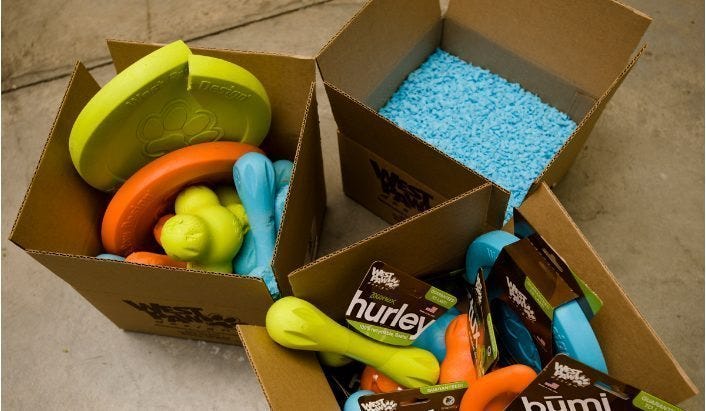How to Minimize the Carbon Pawprint of Our Furry Friends
Many of us count our pets among our best friends. Animal companions bring joy, but they also pack a sizable environmental impact. And for those who keep several pets, the environmental impact can get pretty massive.
You might think we’re an alarmist. How much harm can some puppies and the odd parrot really do? Read below to find out and learn how to minimize the carbon footprint of your furry, finned or feathered friend.
1. Procurement

Adopting an animal in need rather than special-ordering your buddy is a simple and incredibly effective way to do good.
- You give a home — and a chance at life — to a creature in need. 2.7 million cats and dogs are euthanized each year because there are more pets up for adoption than people adopting. Getting your friend spayed or neutered also will help address the overpopulation problem.
- You avoid paying into potentially shady breeding operations.
- Adopting locally means cutting emissions associated with long-distance pickup or delivery from breeders.
- Many cats and dogs in shelters are already house trained and won’t create waste by ruining your carpet, killing your couch, or leaving other fun surprises.
RoundPeg is part of the community of businesses that have used a third-party verification of their impact. Use the free B Impact Assessment to evaluate your company’s impact on all stakeholders, including the environment, your workers, your community and your customers.
2. Nourishment
Sustainable living experts Robert and Brenda Vale categorized ingredients in common pet foods as meats or cereals, calculated the pre-dried weight of ingredients, and added up the carbon emissions associated with the production of each material.
Annual carbon emissions associated with feeding a pet for a year:
- German shepherds: 1.1 hectares (An SUV is 0.41)
- Cats: 0.15 ha (Slightly less than a Volkswagen Golf)
- Hamsters: 0.014 ha (Two hamsters ~ a medium-size plasma TV)
- Goldfish: 0.00034 ha (An eco-finprint equal to two cellphones)
Surprised? Bothered? Many of the strategies you use to curb your own carbon footprint can be applied to pet-feeding as well.

Buy Organic
Organic pet food, like organic people food, is better for farmers, the environment and the one eating it!
Make Your Own—with Care
Buy from local food producers to make your own pet food. By buying locally, you forgo the emissions associated with producing and delivering gigantic bags of food.
It’s worth noting that many vets advise against cooking your own cat food because it can lead to dangerously low levels of the essential nutrient taurine. DIY-ing your dog food is also a task that requires consultation with vets to ensure the right balance of nutrients. If you want to make your own pet food, make sure you’re doing it with expert input to keep your friends healthy and happy.
Don’t Hate on Byproducts
As Susan McGrath of the Audubon Society explains, avoiding meat byproducts in pet food is “un-green.” When meat is processed for human consumption there are leftovers, not because the remnants are inedible but because we don’t happen to eat them. Using these byproducts in pet food diverts them from the waste stream. It’s also good for your pets!
According to Marion Nestle, the Paulette Goddard professor of nutrition, food studies, and public health at New York University, “If we didn’t feed byproducts to pets, the dogs and cats in the U.S. alone would need the amount of food it would take to feed 32 million humans, on a calorie basis.”
DIY Treats
Even if you’re buying commercial food, it’s not hard to green your pet’s treats. Cook up a batch for your dog or cat with sustainably produced ingredients or treat them from your own eco-friendly leftovers.
Other Considerations
Choose bulk packaging to avoid tossing out a tin every day. For cats and dogs, choose fish and chicken-based food because raising these meats is less taxing on the environment.
3. Nourishment Outputs (Poop)
It’s crappy, but pet waste is a big problem. How big? Let these horrifying facts disgust you and convince you to adopt the fixes.
SHOCKING FACT:
Scientists attribute roughly 16% of sea otter deaths to Toxoplasma gondii, a pathogen that lives in cat poop. The toxin has been found in dolphins, walruses, beluga whales and polar bears. In humans, it’s associated with miscarriages, fatal food poisoning and schizophrenia.
FIX:
Bag the poop in a (preferably biodegradable) plastic bag and toss it in the trash. Don’t flush it because sewage treatment doesn’t necessarily kill Toxo. Keep your cat indoors as much as possible.
SHOCKING FACT:
The silicate and clay materials used in clumping cat litter are acquired through strip mining. In the U.S., we dispose of more than 2 million tons of cat litter each year.
FIX:
Use greener litters made from materials like recycled newspapers, renewable wheat crops, corn (of which we have a great excess) or hardwood.
SHOCKING FACT:
In the U.S., roughly 83 million pet dogs produce roughly 10.6 million tons of poop every year. A gram contains roughly 23 million bacteria and several harmful pathogens. In urban watersheds analyses, doggie droppings are the source of 20%–30% of the contaminants found in water samples.
FIX:
Pick up the poop. Use plastic bags you’ve amassed or biodegradable doggy bags. It’s arguable whether there’s enough oxygen for the bags and their contents to biodegrade in landfills, but if there is, only a really biodegradable bag will do so without creating harmful chemical byproducts. Look for the Biodegradable Products Institute logo.
You can also compost dog and cat waste though the resulting biomass should NOT be used on edibles. Learn more about the process here.
4. Entertainment
Get crafty and make pet toys by repurposing materials you already have lying around. Get some good ideas for DIY:

Is your companion of a less common sort? Google the animal name and “DIY toys.” You’ll find ways to entertain everything from betta fish to guinea pigs.
Buying new? Look for toys made from safe materials to minimize your buddies’ exposure to contaminants. B Corp West Paw Design makes the Zogoflex, which can be ground up and recycled into more Zogoflex toys indefinitely, which means a closed loop and zero waste. They also make toys out of organic hemp and IntelliLoft — a fluff made from recycled bottles!
Also check out the newly certified B Corp P.L.A.Y. — Pet Lifestyle and You — for eco-friendly toys like this eggplant plush filled with PlanetFill, another fluff-from-recycled-bottles filler.
EarthDog makes hemp leashes, collars, rope toys, beds and blankets and donates 10% of proceeds to kody’s fund, a nonprofit organization that funds spay and neuter programs.
You can also check out Earth Doggy, Only Natural Pet and Beco Pets for other eco friendly pet products.
If you’re determined to do good and appreciate a chic aesthetic, look at Found My Animal’s collars, leashes and portable bowls. This Brooklyn-based B Corp donates a portion of profits to animal rescue organizations.
5. Medical Treatment
Some ailments require traditional veterinary treatments, but holistic products can address a variety of ills.
B Corp Farm Dog Naturals makes herbal remedies to promote relaxation, soothe surface wounds, and protect dry noses and paw pads. You can also explore natural and home remedies to help with everything from fleas to dry skin to upset tummies to hairballs.
Be careful — some substances that are safe for people are dangerous for pets, and some people on the internet are wrong. Always check with your vet before trying a treatment.
6. Hygienic Enhancement
Try organic or natural shampoos for your dogs and cats. Birds can be washed with just water and some Dawn if they’re extremely dirty. Snakes, turtles and other reptiles can usually be washed with just clean water, but make sure to watch out for chlorine, zinc and other elements that may be present in your tap water and potentially harmful to your pets. We’re 99% sure you don’t have to wash fish.
7. Environmental Involvement
Domestic cats kill 60 million to 70 million wild birds annually in Canada alone. Keep tabs on your Sylvesters to protect the Tweetys. Keeping cats inside also will increase the lifespan of your whiskered friend, so it’s a double win. An outdoor enclosure is a good compromise for more adventurous domesticated felines.
Are you a dog person? You’re not off the hook. Dogs can have a negative impact on wildlife through direct predation, indirect predation, and disease transmission. While the biggest offenders are “free-roaming” dogs, do your part by keeping Fido from killing little animals and infecting lions with canine distemper.
8. Retirement
Go for an eco-friendly bed made in the USA for your dog or cat like the ones from B Corps West Paw Design. If your dog destroys a bed, don’t mess around — go for one that’s really chew-proof to minimize future purchases.
Besides offering a huge variety of traditional pet beds, B Corp P.L.A.Y. also makes a very innovative product called the build-a-bed. You buy a fill-a-bed and a cover and then fill the fill-a-bed with old clothes, towels, sheets and other textiles that have seen better days. It’s a great way to REUSE old stuff, REDUCE the amount of waste you produce, and make your pet a cozy bed to boot!
You can DIY cat beds by repurposing cast offs like old computers. That’s a major #sustainabilitywin!
Most people can’t devote themselves to being a line cook for their pets, but it’s important for conscious consumers to examine even the more obscure facets of sustainable living. No one has the time and money to do everything on a green living list, but by examining different areas of our lives and doing what we can, we can make significant gains in minimizing our environmental impact. Now that effort deserves a round of a-paws!
This article was originally published by RoundPeg. B the Change gathers and shares the voices from within the movement of people using business as a force for good and the community of Certified B Corporations. The opinions expressed do not necessarily reflect those of the nonprofit B Lab.

8 Tips for Planet-Friendly Pet Care was originally published in B the Change on Medium, where people are continuing the conversation by highlighting and responding to this story.